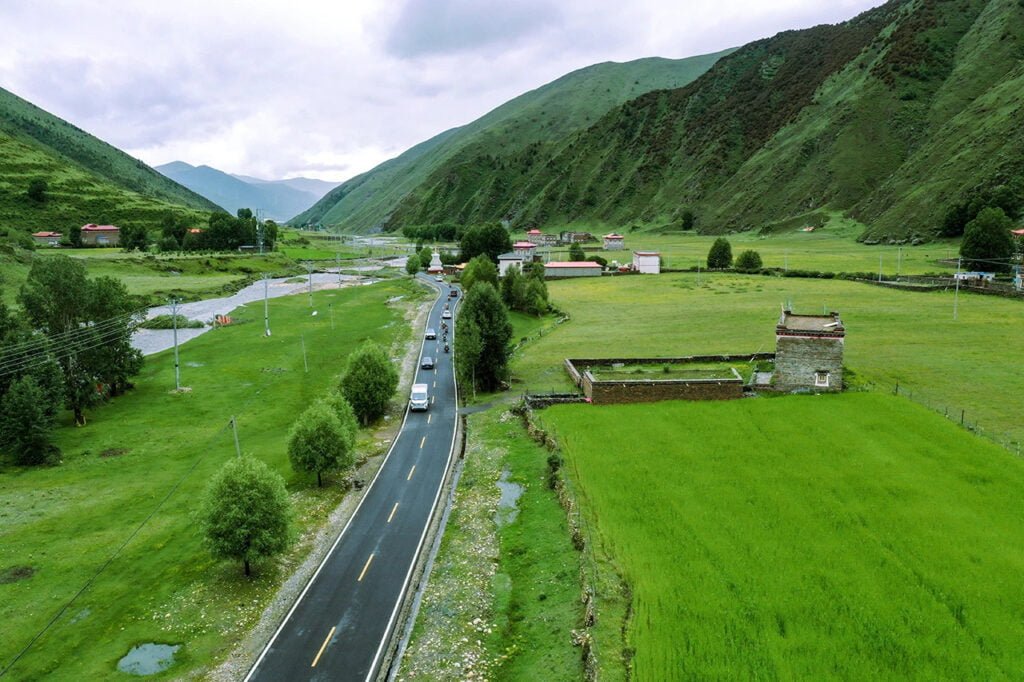Traveling to Tibet offers unique experiences amidst stunning landscapes, but it also demands thoughtful preparation, especially for travelers unfamiliar with high-altitude environments and Tibetan cultural traditions. In this guide, we provide crucial information on physical preparation, insurance needs, essential travel documents, weather-related necessities, safety guidelines, and respectful etiquette to ensure a fulfilling and respectful journey in Tibet.

Physical Preparation for Altitude Sickness: Safeguarding Your Health
One of the most significant challenges of traveling to Tibet is adjusting to high altitudes. The thin air in Tibet means less oxygen, and even seasoned travelers may experience Altitude Sickness (AS) if they’re unaccustomed to these conditions. Symptoms of AS include headaches, breathlessness, fever, loss of appetite, restlessness, and stomach issues. Here’s how you can prepare your body and minimize risks associated with altitude sickness:
- Undergo a Physical Examination: Before traveling to Tibet, consider consulting a healthcare provider for a general check-up to ensure your body can withstand high elevations. If you have respiratory, cardiac, or other health issues, it’s wise to discuss your travel plans with a medical professional.
- Acclimate Gradually: Altitude sickness can often be managed by allowing time for gradual acclimatization. Start your journey in a lower-altitude location, such as Lhasa, before moving on to higher regions. Spending at least a day or two adjusting can make a significant difference in your body’s response to the altitude.
- Consider Preventive Medication: Medications like acetazolamide (Diamox) may help prevent or reduce symptoms of altitude sickness. Consult your doctor for dosage recommendations and to see if this medication suits your health profile.
- Build Endurance: Engaging in regular cardio exercise—such as jogging, swimming, or cycling—can improve lung capacity and overall stamina, which are beneficial for handling the decreased oxygen levels at high altitudes.
- Hydrate and Eat Lightly: Staying well-hydrated helps your body adjust to high altitudes. Avoid alcohol and heavy meals upon arrival, as these can worsen symptoms of altitude sickness.
Insurance: Essential Coverage for Your Peace of Mind
Securing comprehensive travel insurance before embarking on any journey is a good habit, especially in Tibet, where the unpredictable climate, high altitudes, and limited healthcare facilities mean unexpected situations can arise. Look for insurance that includes:
- Health Insurance: Ensure that your travel insurance includes health coverage that’s valid in Tibet, including emergency evacuation and high-altitude sickness treatment.
- Property and Theft Coverage: Insurance covering personal belongings, such as electronics and documents, can be useful in case of loss or theft.
- Trip Cancellation Insurance: Travel plans can change due to weather or health conditions in Tibet, so trip cancellation coverage can protect you financially if you need to alter your plans.
Travel Documents and Essentials: What to Pack for a Smooth Journey
Preparing the right documents and essentials for Tibet ensures that you won’t encounter complications during your trip. Below are key items to remember:
- Valid ID and Travel Permits: A valid passport, visa, and the Tibet Travel Permit are essential for entry into Tibet. Keep both digital and physical copies of these documents.
- Credit Cards and Local Currency: While major cities in Tibet accept credit cards, rural areas may not, so carrying cash (in the local currency, Chinese Yuan) is recommended.
- Seasonal Clothing: Tibet’s weather can be unpredictable, with significant temperature variations between day and night. Layering is essential, so pack sweaters, jackets, and warm clothing to stay comfortable.
- First Aid Kit: Prepare a small first-aid kit with basic medications, such as altitude sickness tablets, pain relievers, and stomach remedies. A portable oxygen canister may also be useful for high-altitude areas.
- Sun Protection Essentials: Tibet’s high altitude makes the sunlight more intense, so UV protection is crucial. Bring a high-SPF sunscreen, sunglasses with UV protection, and a hat to protect your skin and eyes from harmful rays.
Safety Tips: Protecting Yourself and Your Belongings
Tibet is generally a safe destination, but some precautions can ensure a hassle-free experience. Here are key safety tips to consider:
- Avoid Sensitive Topics: Tibetan politics and religious issues are sensitive in Tibet and China, so it’s advisable to avoid discussing these topics with locals or during your travels. Respect the local regulations and customs to maintain a harmonious experience.
- Stay Aware of Your Surroundings: While Tibetans are known for their warmth and hospitality, it’s wise to remain vigilant with your belongings. Keep valuables secure, especially in crowded tourist areas, and avoid displaying large amounts of cash.
- Team Travel and Communication: If you’re traveling with a group, always let your companions know your whereabouts. Team awareness is vital in remote areas, where communication and assistance may be limited.
- Respect Local Boundaries and Sacred Areas: Certain temples, monasteries, and cultural sites have rules that visitors are expected to follow. Always adhere to posted signs and instructions from local guides to avoid accidental disrespect.
Cultural Etiquette in Tibet: Showing Respect to Locals
Tibetan culture is rich and deeply rooted in tradition, so understanding and respecting local customs is essential. Here are some key etiquette guidelines:
- Entering Homes and Tents: When invited into a Tibetan home or tent, avoid stepping on the threshold, as it’s considered impolite.
- Respectful Addressing: Addressing someone by adding “La” after their name shows respect. For instance, addressing a person as “Tashi La” conveys politeness.
- Seating Manners: If offered a seat, sit cross-legged and avoid pointing your feet at others. Stretching your legs or showing the soles of your feet toward others can be seen as disrespectful.
- Accepting and Offering Gifts: Gifts are often exchanged in Tibetan culture. When receiving a gift, use both hands to show appreciation. Similarly, when offering a gift, bow slightly and present it with both hands above your head.
- Offering Food and Drinks: When serving tea, wine, or cigarettes, always offer them with both hands, and avoid placing your fingers inside the cup, as this gesture is considered rude.
- Avoiding Certain Animals as Food: Tibetans traditionally avoid eating certain animals, including horses, dogs, donkeys, and, in some regions, even fish. Respect local dietary customs when dining or sharing meals with Tibetans.
- Avoiding Impolite Gestures: Gestures like clapping behind someone’s back or spitting are considered highly disrespectful in Tibetan culture. Show respect by refraining from such behaviors.
Temple and Monastery Etiquette: Honoring Sacred Spaces
Temples and monasteries are sacred places in Tibet, and certain guidelines should be followed to show respect for the Tibetan Buddhist faith:
- No Smoking, No Touching: Smoking and touching religious statues or artifacts inside temples is strictly prohibited. Respect the sanctity of these spaces by refraining from physical contact with religious items unless instructed otherwise.
- Photography Restrictions: Many temples and monasteries restrict photography to protect the sacredness of their spaces. Avoid taking pictures inside temples unless permitted, and always ask for permission before photographing monks or locals.
- Walking Clockwise: When visiting a temple, walk in a clockwise direction around shrines, stupas, and mani stone piles. This shows respect for Tibetan Buddhist traditions. Followers of the Bon religion walk in a counter-clockwise direction, but visitors to Buddhist sites should observe the clockwise rule unless instructed otherwise.
- Respect Sacred Symbols: Mani stone piles, stupas, and other sacred symbols can be found along paths and temples. Walk around them clockwise to show respect, and avoid stepping over or sitting on these symbols.

